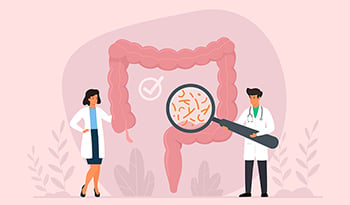GLP-1 And Gut Health: A Key Hormone For Digestive Wellness

The gastrointestinal system is central to a variety of biological functions the body carries out in the day-to-day, playing a vital role in digestion, nutrient absorption, immune function, and metabolic regulation. Among the many players that influence digestive function is a powerful hormone called glucagon-like peptide 1, or GLP-1.
While GLP-1 is most commonly recognized for its role in blood sugar regulation, weight loss, and weight management, its impact on the digestive system is equally important and of key clinical consideration when addressing the connection between the gut and metabolic health.
In this article, we explore the function of GLP-1 and its receptors, highlighting their role in digestive support, gut integrity, microbiome health, and emerging applications in gastrointestinal wellness.
What Is GLP-1?
GLP-1 is a hormone produced by the intestinal cells—specifically, the enteroendocrine L cells of the small intestine—in response to eating. After a meal, GLP-1 is secreted into the bloodstream and interacts with its receptors, which are located throughout the body, including the gastrointestinal tract, pancreas, and brain.
Once activated, GLP-1 receptors help regulate several important physiological processes. These include slowing gastric emptying, supporting insulin secretion, modulating appetite, and influencing how nutrients are digested and absorbed. By slowing the movement of food from the stomach into the intestines, GLP-1 promotes better nutrient absorption and helps stabilize post-meal blood glucose levels to support overall metabolic health.
How GLP-1 Receptors Influence Digestive Health
GLP-1 receptors play a multifunctional role in the gut, affecting motility, secretions, immune function, and microbial balance. Activation of these receptors supports digestive health through several key mechanisms:
One of GLP-1’s primary actions is to slow gastric emptying, allowing food to move more gradually through the digestive tract. This not only improves nutrient absorption but also prevents the stomach from becoming overburdened, helping to reduce symptoms like bloating or cramping in some individuals.1,2
Additionally, GLP-1 signaling may help soothe the gastrointestinal lining by modulating the secretion of gastric acids and reducing excessive motility in the upper GI tract. These actions may contribute to less irritation of the gut lining, especially in individuals with sensitive digestion.2,3
Research also suggests that GLP-1 activity may influence bowel regularity. By regulating the pace at which food and nutrients move through the intestines, GLP-1 may help reduce episodes of diarrhea in certain conditions where transit time is abnormally fast.2,4
Emerging studies indicate that GLP-1 may also contribute to the health of the gut microbiome. Some research suggests that this hormone may help promote microbial diversity in the gut microbiome, including increases in beneficial bacterial populations such as Bacteroidetes, while also helping maintain the integrity of the gut barrier through its influence on immune signaling. These effects may help modulate inflammatory pathways and support a balanced immune response within the gut.5,6
GLP-1 Agonists And Digestive Health: An Area Of Emerging Research
GLP-1 receptor agonists—medications designed to mimic the effects of natural GLP-1—are already widely used in the treatment of type 2 diabetes and obesity. However, recent clinical studies are now beginning to explore their potential role in managing gastrointestinal and inflammatory conditions.
In some studies, GLP-1 agonists have been shown to activate immune cells that release interleukin-22 (IL-22), a cytokine that helps support the health of the intestinal lining. This action may be beneficial for individuals dealing with symptoms of inflammatory bowel disease (IBD), such as diarrhea.7 In fact, observational research has noted that individuals with IBD who used GLP-1 agonists had a reduced risk of needing surgery, suggesting a potential slowing of disease progression.
While more research is needed to confirm these findings, this growing body of evidence indicates that GLP-1 pathways may have protective effects in the digestive tract, beyond their traditional use in metabolic care. Always remember to seek the advice of your healthcare provider to explore options and before making changes to current wellness routines.
Summary: The Broader Role Of GLP-1 In Gut Health
GLP-1 and its receptors are emerging as critical regulators of digestive health, with roles that extend beyond weight loss and blood sugar control. From modulating gastric emptying and promoting nutrient absorption to influencing the gut microbiome and supporting immune balance, GLP-1 helps maintain a healthy and functional gastrointestinal system.
As researchers continue to explore the diverse benefits of GLP-1, including its therapeutic applications in gut inflammation and microbiome modulation, this hormone may play an even larger role in future digestive health strategies.
References:
- Drucker DJ.Gastroenterology. 2002;122(2):531-544. https://pubmed.ncbi.nlm.nih.gov/11832466/
- Holst JJ et al. Br J Pharmacol. 2022;179(4):727-742. https://pubmed.ncbi.nlm.nih.gov/35231672/
- Maselli DB et al. Adv Exp Med Biol. 2021;1307:171-192. https://pubmed.ncbi.nlm.nih.gov/32077010/
- Smits MM et al. Diabetes Obes Metab. 2016;18(3):224-235. https://pubmed.ncbi.nlm.nih.gov/26500045/
- Abdalqadir N et al. Microorganisms. 2022;10(10):2061. https://www.mdpi.com/2076-2607/10/10/2061
- Sun H et al. Immunology. 2024;172(3):451-468. https://pubmed.ncbi.nlm.nih.gov/38544428/
- Desai A et al. Aliment Pharmacol Ther. 2024;60(5):620-632. https://pubmed.ncbi.nlm.nih.gov/38938071/
DISCLAIMER:This Wellness Hub does not intend to provide diagnosis...













































































 Table of Contents
Table of Contents















